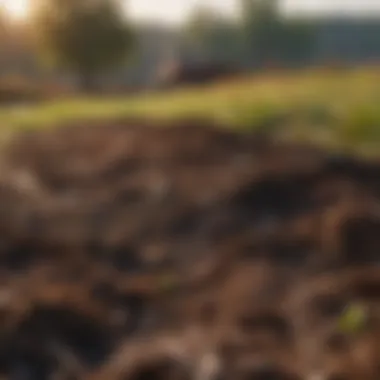Dive Into the Array of Composting Techniques for Sustainable Waste Management


Overview of Composting Methods
Composting methods are vital for sustainable waste management, playing a significant role in environmental conservation. By converting organic waste into nutrient-rich soil amendments, these methods promote resource sustainability and contribute to a greener planet. Understanding the various types of composting techniques is crucial for addressing waste management challenges and fostering environmental stewardship.
Types of Composting Methods
Traditional Composting
Traditional composting involves pile composting, wherein organic waste materials are accumulated in a designated area and left to decompose naturally. This method is cost-effective and straightforward, making it accessible for home gardeners and small-scale waste producers. The process typically requires turning the compost periodically to aerate it and facilitate decomposition.
Vermicomposting
Vermicomposting utilizes worms to break down organic matter and accelerate the composting process. Worms ingest organic waste, and their castings, known as vermicast, are rich in nutrients beneficial for plant growth. This method is suitable for small spaces and is an excellent option for urban dwellers looking to compost indoors.
Aerated Static Pile Composting
Aerated static pile composting involves the use of perforated pipes to introduce air into the compost pile, enhancing oxygen supply for microorganisms responsible for decomposition. This method speeds up the composting process and is employed in large-scale composting operations to manage significant volumes of organic waste efficiently.
Bokashi Composting
Bokashi composting relies on fermentation to break down organic waste. By fermenting food scraps with the help of inoculated bran, this method eliminates odors and accelerates decomposition. The fermented material can later be mixed with soil to create nutrient-rich compost, making it a convenient option for households with limited space.
Advantages of Composting


Composting offers a myriad of benefits, including diverting organic waste from landfills, reducing greenhouse gas emissions, and enriching soil health. By incorporating composting into waste management practices, individuals and communities can contribute significantly to environmental sustainability and resource conservation.
Implementing Composting Practices
To effectively implement composting practices, it is essential to educate individuals on the importance of segregating organic waste, providing necessary infrastructure for composting, and establishing partnerships with local authorities and community organizations. By fostering a culture of composting, we can collectively work towards a more sustainable future and a cleaner environment for generations to come.
Introduction to Composting
Composting is a fundamental practice in sustainable waste management, pivotal in converting organic waste into valuable soil amendments. This section serves as the foundational cornerstone for understanding the various composting methods discussed in the subsequent sections. Addressing the essence of composting involves recognizing its pivotal role in environmental conservation and resource sustainability. By decomposing organic matter, composting generates nutrient-rich soil additives, promoting ecosystem health and biodiversity. Moreover, composting aids in waste reduction and plays a crucial part in mitigating greenhouse gas emissions. When exploring composting, factors like optimal waste segregation, moisture levels, aeration, and temperature regulation are essential considerations.
Understanding the Significance of Composting
Understanding the significance of composting delves into the multifaceted benefits it offers to the environment and society at large. Composting represents a natural process that mimics nature's decomposition cycle, fostering soil fertility and enhancing plant growth. By converting organic waste into humus, compost enriches soil structure, moisture retention, and nutrient content. This not only reduces the reliance on chemical fertilizers but also minimizes landfill waste accumulation. Composting showcases a closed-loop system where waste is transformed into a valuable resource, aligning with circular economy principles. Embracing composting is a holistic approach towards sustainable waste management, demonstrating a harmonious relationship between human activities and ecological well-being.
Traditional Composting Methods
Traditional composting methods are a cornerstone of sustainable waste management practices. By harnessing the natural decomposition process of organic materials, traditional composting methods play a vital role in reducing landfill waste and producing nutrient-rich soil amendments. One significant element to consider is the inexpensiveness of traditional composting, making it accessible for individuals and communities alike. The benefits of traditional composting methods extend beyond waste reduction, allowing for the creation of fertile soil that promotes plant growth and biodiversity. However, it is essential to consider the proper balance of materials, moisture levels, and aeration in traditional composting to ensure optimal decomposition and nutrient retention.
Pile Composting
Pile composting involves creating a mound or heap of organic waste materials to facilitate decomposition. This method is popular for its simplicity and minimal requirements, making it suitable for beginners and small-scale composting initiatives. The key to successful pile composting lies in achieving the right mix of carbon-rich (browns) and nitrogen-rich (greens) materials, ensuring proper heat generation and microbial activity. Regular turning or aerating the compost pile promotes oxygen flow and accelerates the decomposition process, resulting in high-quality compost for soil enrichment.
Bin Composting


Bin composting utilizes enclosed containers or bins to hold organic waste and facilitate controlled decomposition. This method is ideal for urban settings or limited spaces, offering a neat and contained composting solution. The key advantage of bin composting is its ability to regulate moisture and temperature levels effectively, creating optimal conditions for microbial digestion. By regularly rotating or mixing the contents, bin composting ensures even decomposition and prevents odors or pest infestations. Bin composting is a practical choice for individuals seeking a convenient and space-efficient composting method.
Vermicomposting
Vermicomposting involves the use of earthworms to break down organic matter into nutrient-rich vermicompost. This method is particularly efficient in processing kitchen scraps and small plant trimmings, producing high-quality compost within a relatively short timeframe. Vermicomposting benefits from earthworms' ability to enhance microbial activity and nutrient breakdown through their digestion process. Maintaining ideal moisture and temperature levels is crucial for successful vermicomposting, as it sustains the worm population and ensures efficient decomposition. Vermicomposting is a versatile and eco-friendly composting method suitable for indoor or outdoor applications.
Innovative Composting Methods
In the realm of composting for sustainable waste management, the exploration of innovative methods holds a significant position. Unlike traditional composting approaches, innovative methods offer unique solutions and benefits that cater to specific needs and challenges. Through their emphasis on efficiency and effectiveness, these methods contribute to optimizing the composting process and enhancing sustainability practices. The integration of innovative composting techniques into waste management strategies underscores a forward-thinking approach that aligns with modern environmental conservation goals.
Bokashi Composting
Bokashi composting stands out as a distinctive method within the realm of innovative composting techniques. Originating from Japanese practices, Bokashi composting involves fermenting organic waste with the help of beneficial microbes. This anaerobic process enables the breakdown of food scraps, including meat and dairy, which are typically excluded from traditional composting methods. The resulting nutrient-rich liquid produced during Bokashi composting can be utilized as a potent organic fertilizer for plants, contributing to sustainable agriculture practices. Additionally, the compact nature of Bokashi composting systems makes them suitable for urban dwellings and smaller spaces, promoting composting in diverse residential settings.
Trench Composting
Trench composting represents a simple yet effective method to recycle organic waste and enrich soil fertility. This approach involves digging trenches in designated areas and burying food scraps and biodegradable materials underground. As the organic matter decomposes within the trenches, it gradually releases nutrients into the surrounding soil, improving its structure and vitality. Trench composting not only avoids the need for specialized bins or containers but also promotes soil health through natural decomposition processes. By incorporating trench composting into backyard gardens or agricultural fields, individuals can practice sustainable waste management while enhancing the productivity of their land.
Black Soldier Fly Composting
Black Soldier Fly (BSF) composting presents a unique biological solution for converting organic waste into valuable resources. The larvae of black soldier flies are adept at consuming a wide range of organic materials, efficiently breaking them down into nutrient-rich frass. Through BSF composting, these voracious larvae assist in reducing waste volume and odors while producing a high-quality organic amendment. The resulting frass, or composted residue, offers significant benefits for soil health and plant growth, serving as a natural fertilizer rich in essential nutrients. As an environmentally friendly approach, Black Soldier Fly composting showcases the potential of insect-based systems in sustainable waste management, demonstrating nature-inspired solutions for organic recycling.
Commercial Composting Methods


Commercial composting methods are integral to sustainable waste management practices, playing a crucial role in transforming organic waste into valuable soil amendments. This section explores the significance of employing commercial techniques in large-scale waste processing operations. Companies and municipalities utilize these methods to optimize waste diversion from landfills, reduce greenhouse gas emissions, and produce high-quality compost for agricultural and horticultural applications. The benefits of commercial composting include efficient organic matter breakdown, control of moisture and aeration levels, and the ability to scale operations according to waste volume and composition. Considerations such as regulatory compliance, odor control, and facility infrastructure are vital for the successful implementation of commercial composting methods.
Large-Scale Windrow Composting
Large-scale windrow composting involves arranging organic materials into long, peaked rows to facilitate aerobic decomposition. This method is commonly used by composting facilities due to its cost-effectiveness and simplicity. The windrows are periodically turned using specialized equipment to ensure proper aeration and microbial activity, speeding up the composting process. Temperature monitoring is crucial to achieve optimal decomposition rates and pathogen elimination. The resulting compost is then cured to stabilize the organic matter and enhance nutrient content before distribution. Large-scale windrow composting is favored for its ability to process significant quantities of organic waste efficiently while producing high-quality compost.
In-Vessel Composting
In-vessel composting is a controlled process that takes place inside enclosed containers or vessels, allowing for precise management of environmental factors such as temperature, moisture, and aeration. This method is ideal for processing food waste, yard trimmings, and other organic materials in urban settings or areas with limited space. In-vessel composting systems utilize mechanical agitation or forced aeration to promote microbial growth and accelerate the composting process. The controlled conditions help mitigate odors and greenhouse gas emissions, making it a sustainable option for organic waste management in densely populated areas.
Aerated Static Pile Composting
Aerated static pile composting involves the creation of compost piles that are aerated using pipes or blowers to maintain oxygen levels throughout the pile. This method enhances decomposition efficiency by providing adequate oxygen to aerobic microorganisms responsible for breaking down organic matter. The piles are periodically monitored and turned to ensure uniform composting and proper moisture levels. Aerated static pile composting is well-suited for large-scale operations, offering benefits such as reduced composting time, improved odor control, and the production of a more uniform compost product. Its efficient nutrient conversion and minimal land use requirements make it a promising approach for sustainable waste management practices.
Community-Based Composting Initiatives
Community-based composting initiatives play a vital role in promoting sustainable waste management practices. These initiatives involve collaboration at the grassroots level, engaging local communities in composting activities to reduce organic waste and produce valuable compost. By focusing on community-based composting, environmental impact is localized, bringing about a tangible change in waste management practices. Communities can actively participate in waste reduction efforts, creating a sustainable ecosystem that fosters environmental awareness and responsibility. These initiatives not only help in waste reduction but also serve as educational platforms, raising awareness about the importance of composting and its benefits to the environment.
School Composting Programs
School composting programs are essential in educating the younger generation about waste management and environmental conservation. By integrating composting into school curriculum, students learn hands-on about the process of composting, the value of organic waste, and the benefits of recycling materials naturally. These programs instill eco-conscious values in students, fostering a sense of responsibility towards the environment. Schools that implement composting programs also reduce their ecological footprint by diverting organic waste from landfills, creating a greener and more sustainable learning environment.
Urban Composting Cooperatives
Urban composting cooperatives are collaborative efforts within urban areas to manage organic waste effectively. These cooperatives bring together residents, local businesses, and community organizations to collectively compost organic materials, turning waste into a resource. By establishing urban composting cooperatives, cities can reduce the burden on municipal waste management systems and promote community engagement in sustainable practices. These cooperatives empower urban dwellers to take control of their waste output, emphasizing the importance of individual contribution to environmental sustainability.
Residential Composting Schemes
Residential composting schemes provide homeowners with the opportunity to take charge of their organic waste disposal. By implementing composting systems at home, residents can reduce the amount of waste sent to landfills, decreasing methane emissions and promoting soil health. Residential composting schemes encourage sustainable practices at the household level, fostering a culture of environmental responsibility and resource conservation. Through simple yet effective composting techniques, households can actively contribute to waste reduction efforts and create nutrient-rich soil amendments for their gardens.



